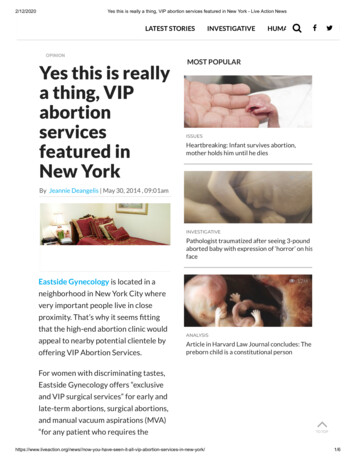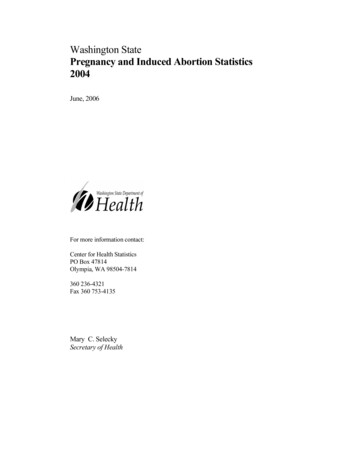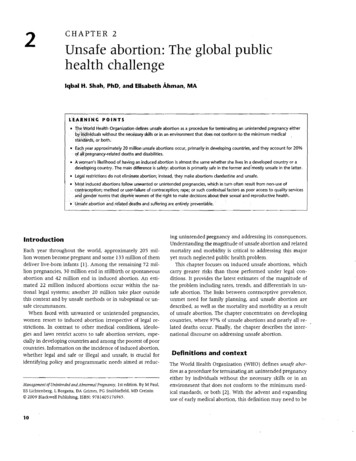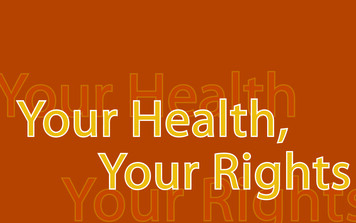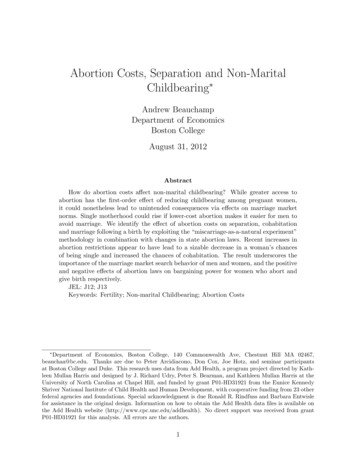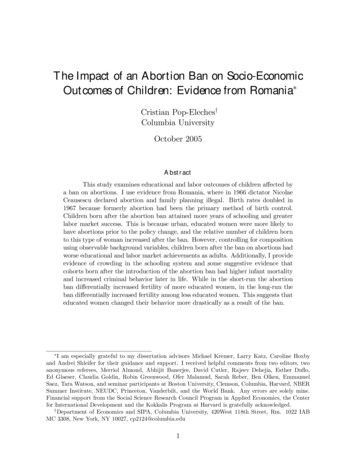
Transcription
The Impact of an Abortion Ban on Socio-EconomicOutcomes of Children: Evidence from Romania Cristian Pop-Eleches†Columbia UniversityOctober 2005AbstractThis study examines educational and labor outcomes of children affected bya ban on abortions. I use evidence from Romania, where in 1966 dictator NicolaeCeausescu declared abortion and family planning illegal. Birth rates doubled in1967 because formerly abortion had been the primary method of birth control.Children born after the abortion ban attained more years of schooling and greaterlabor market success. This is because urban, educated women were more likely tohave abortions prior to the policy change, and the relative number of children bornto this type of woman increased after the ban. However, controlling for compositionusing observable background variables, children born after the ban on abortions hadworse educational and labor market achievements as adults. Additionally, I provideevidence of crowding in the schooling system and some suggestive evidence thatcohorts born after the introduction of the abortion ban had higher infant mortalityand increased criminal behavior later in life. While in the short-run the abortionban differentially increased fertility of more educated women, in the long-run theban differentially increased fertility among less educated women. This suggests thateducated women changed their behavior more drastically as a result of the ban. I am especially grateful to my dissertation advisors Michael Kremer, Larry Katz, Caroline Hoxbyand Andrei Shleifer for their guidance and support. I received helpful comments from two editors, twoanonymous referees, Merriol Almond, Abhijit Banerjee, David Cutler, Rajeev Dehejia, Esther Dußo,Ed Glaeser, Claudia Goldin, Robin Greenwood, Ofer Malamud, Sarah Reber, Ben Olken, EmmanuelSaez, Tara Watson, and seminar participants at Boston University, Clemson, Columbia, Harvard, NBERSummer Institute, NEUDC, Princeton, Vanderbilt, and the World Bank. Any errors are solely mine.Financial support from the Social Science Research Council Program in Applied Economics, the Centerfor International Development and the Kokkalis Program at Harvard is gratefully acknowledged.†Department of Economics and SIPA, Columbia University, 420West 118th Street, Rm. 1022 IABMC 3308, New York, NY 10027, cp2124@columbia.edu1
1IntroductionA number of recent studies have used the legalization of abortion in the US in the 1970’sto analyze how the change in access to abortion affects child outcomes later in life. Thesestudies Þnd that the cohorts of children resulting from pregnancies that could have beenlegally terminated display better socio-economic outcomes along a wide range of indicators: they are less likely to live in a single household and less likely to live in poverty andin a household receiving welfare (Gruber, Levine, and Staiger, 1999), they consume fewercontrolled substances (Charles and Stephens, 2002), have lower teen childbearing rates(Donohue, Grogger and Levitt, 2002) and are less likely to commit crimes (Donohue andLevitt, 2001).This paper is also an effort to understand the link between access to abortion and socioeconomic outcomes of children, but using a major policy change in the opposite direction.In 1966 Romania abruptly shifted from one of the most liberal abortion policies in theworld to a very restrictive regime that made abortion and family planning illegal for mostwomen. This policy was maintained, with only minor modiÞcations, until December 1989,when following the fall of communism, Romania reverted back to a liberal policy regardingabortion and modern contraceptives. The short-run impact of the 1966 change in policywas an immediate and enormous increase in births: the total fertility rate increased from1.9 to 3.7 children per woman between 1966 and 1967.On average, children born in 1967 just after abortion became illegal display signiÞcantly better educational and labor market achievements than children born just prior tothe change. This seemingly paradoxical result is the opposite of what one would expect inlight of the Þndings from the US, but can be explained by a change in the composition ofwomen having children: urban, educated women were more likely to have abortions priorto the policy change, so a higher proportion of children were born into urban, educatedhouseholds after abortions became illegal. Controlling for this type of composition usingobservable background variables, children born after the abortion ban had worse schooling and labor market outcomes. This Þnding is consistent with the view that childrenwho were unwanted during pregnancy had inferior socio-economic outcomes once theybecame adults. Additionally, I provide evidence that the increase in cohort size due to2
the abortion ban resulted in a crowding effect in the schooling system.The Þnal part of the paper contains two extensions to the main analysis. First I showthat while in the short-run the more educated women were mostly affected by the abortionban, in the long-run the less educated women had the largest increases in fertility as aresult of Romania’s 23 year period (1967-1989) of continued pronatalist policies. Thisimplies that educated women changed their behavior more drastically as a result of theban and suggests that more educated women are more effective in reaching their desiredfertility when access to birth control methods is difficult. Secondly, I offer some suggestiveevidence that cohorts born after the introduction of the abortion ban had higher infantmortality and increased criminal behavior later in life.Following is the plan of the paper. Section 2 provides an overview of the channelsthrough which an unwanted birth might affect the socio-economic outcome of a child.Section 3 describes the unusual history of abortion legislation in Romania. In section 4,I describe the data and empirical strategy. Section 5 presents the results of the mainanalysis. Section 6 includes the two extensions and section 7 concludes.2The mechanisms by which an abortion ban affectssocio-economic outcomes of childrenConsider a woman’s decision as to whether to use birth control: if the costs of using acertain birth control method increases substantially, she will likely use less of it. Instead,she will rely on abstinence, use alternative birth control technologies, and/or have morebirths. Thus, the children born under a restrictive birth control regime are more likelyto be unplanned, unwanted or mistimed, relative to a world where a woman exercisedcostless control over her fertility. I will refer to children, whose births are a result of theincreased cost of fertility control, as ”unwanted.” How might unwantedness affect adultoutcomes?A Þrst way in which an unwanted birth might affect the quality of a child derivesfrom the standard model of the child quality/quantity trade-off (Becker, 1981). Since it isassumed that parents desire equal levels of quality for each of their children, an increasein the number of children as a result of an unwanted pregnancy leads to a decrease in3
child quality for all children in the household.Secondly, optimal timing of birth might play an important role in the future development of a child. If access to birth control methods becomes difficult, women are less ableto delay childbearing until conditions are more favorable for raising children. Unfavorableconditions might arise for a number of reasons. Childbearing can conßict with the longerterm educational and labor market plans of a mother (Angrist and Evans, 1996), whichcan have a negative effect on the child. In addition a mother, who gives birth to anunwanted child prior to marriage, might either enter an undesired marriage or face singleparenthood. Finally, a whole range of additional factors, broadly related to a mother’s(and father’s) physical and emotional well-being resulting from involuntary parenthoodmight affect the development of children within a family.Finally, in the presence of selection in terms of pregnancy resolution, a change inaccess to birth control methods can affect the average quality of children. A number ofstudies (Grossman and Jacobowitz 1981; Joyce 1987; Grossman and Joyce 1990) showthat increased access to abortion increased the weight of children at birth and decreasedneonatal mortality, suggesting positive selection on fetal health.The different theoretical channels just reviewed all predict that making access toabortions harder will have a negative effect on a child’s development. Thus, for thepurposes of this paper, I will call the combined effect of the three channels the effect ofunwantedness on child outcomes. In addition to the mentioned US based research, thepapers by Myhrman (1988) for Finland, Bloomberg (1980) for Sweden and Dytrych etal. (1975), David and Matejcek (1981) and David (1986) for the Czech Republic havestudied outcomes of children born to mothers who have been denied access to abortion.Unwanted children display a number of negative outcomes, ranging from poorer health,lower school performance, more neurotic and psychosomatic problems, a higher likelihoodof receiving child welfare, to more contentious relationships with parents and higher teensexual activity. The major drawback of these studies is their inability to convincinglyaccount for the self-selection of a certain type of mothers into the treatment group.11The Heckman bivariate selection model (Heckman, 1979) is the standard approach to control for nonrandom selection into the treatment group. Without making strong structural form assumptions, thisestimator generally needs an exclusion restriction; in this case there are no plausible exclusion restrictionsacross the selection into treatment and child outcome equations.4
There are two additional ways through which a change in abortion legislation couldaffect the average socio-economic outcome of children. First, one has to understand howthe change in policy inßuences the composition of women who carry pregnancies to term.The direction of the effect is theoretically ambiguous and ultimately requires an empiricalanalysis of which types of women are most affected by the change in policy. While theevidence from the US (Gruber, Levine and Staiger, 1999) suggests that women fromdisadvantaged backgrounds are more likely to use abortion and thus are more affectedby a change in abortion regime, the present analysis shows that in the case of Romania,abortion was used primarily by urban, educated women.Finally, if the fertility impact of the ban on abortions is large, one could imagine anegative crowding effect resulting from a larger cohort competing for scarce resources.2The importance of possible crowding effects is an interesting question of its own and willbe addressed in a later section.3Abortion and birth control policy regimes in RomaniaPrior to 1966, Romania had one the most liberal abortion policies in Europe, sinceabortions were legal in the Þrst trimester and provided at no cost by the state health caresystem. Abortion was the most widely used method of birth control (World Bank, 1992)and in 1965, there were four abortions for every live birth (Berelson, 1979). Worried by arapid decrease in fertility,3 Romania’s communist dictator, Nicolae Ceausescu, issued anunexpected decree in the fall of 1966: abortion and family planning were declared illegaland the immediate cessation of abortions was ordered. Legal abortions were allowed onlyfor women over the age of 45, women with more than four children, women with health2Apart from the direct crowding effect caused, for example, by having more children in the schoolsystem, there could also be an additional compositional effect resulting from having proportionally moredifficult peers in school as a result of the abortion ban.3The rapid decrease in fertility in Romania in this period is atributed to the country’s rapid economicand social development and the availability of access to abortion as a method of birth control. Beginningwith the 1950s, Romania enjoyed two decades of continued economic growth as well as large increases ineducational achievements and labor force participation for both men and women.5
problems, and women with pregnancies resulting from rape or incest.The immediate impact of this change in policy was a dramatic increase in births: thebirth rate4 increased from 14.3 to 27.4 between 1966 and 1967 and the total fertility rate5increased from 1.9 to 3.7 children per woman (Legge, 1985). As can be seen in Figure1, the large number of births continued for about 3-4 years, after which the fertility ratestabilized for almost 20 years, albeit at a higher level than the average fertility ratesin Hungary, Bulgaria, and Russia. Abortions remained illegal and the law was strictlyenforced without major modiÞcations until December 1989, when the communist government was overthrown.6 Following the liberalization of access to abortion and moderncontraceptives in 1989, the reversal in trend was immediate, with a decline in the fertilityrate and a sharp increase in the number of abortions. In 1990 alone, there were 1 millionabortions in a country of only 22 million people (World Bank, 1992).This legislative history suggests a simple difference strategy to estimate the effects ofchanges in access to abortion on educational and labor market outcomes of children. Thebasic idea is to compare outcomes of children born just after the policy change and justbefore the change. Figure 2 plots the fertility impact of the policy by month of birth ofthe children. The decree came into effect in December of 1966 and the sharp increase infertility was observed about six months later beginning in June 1967.7 Therefore most ofthe women who gave birth immediately after June of 1967 were already pregnant at thetime the law change happened.8 From July to October of 1967 the average monthly birthrate was about three times higher than during January to May of 1967. A substantialfraction of these children would not have been born in the presence of access to abortion:this is the identiÞcation assumption of my study.4The birth rate is the number of births per 1,000 population in a given year.The total fertility rate is the average total number of births that would be born per woman inher lifetime, assuming no mortality in the childbearing ages, calculated from the age distribution andage-speciÞc fertility rates of a speciÞed group in a given reference period.6I discuss the fertility impact of the policy in detail in Pop-Eleches (2005).7The six month lag between policy announcement and the fertility response results from the fact thata pregnancy lasts about nine months and abortions under the liberal policy were legal within the Þrstthree months of pregnancy.8In fact a rough calculation of the number of pregnancies, abortions, and births around the time ofthe policy suggests that at least in the Þrst couple of months following the ban basically all pregnancieswere carried to term.56
4Data and empirical strategy4.1DataThe primary data for this analysis come from a 15% sample of the Romanian 1992census. This dataset provides basic socio-economic information, such as gender, region ofbirth, educational attainment and labor market outcomes, for about 50,000 individualsfor each year of birth. In addition the census provides not only the year but also themonth of birth for each person, an important variable that will be used to identify theeffect of the abortion ban within a narrow time window.I mainly rely on the sample consisting of all children born between January andOctober 1967, producing more than 55,000 observations. The period between Januaryand October is chosen primarily because it will allow me to separate the crowding effectfrom the other two effects of the abortion ban (unwantedness effect and compositioneffect). Although the spike in births (see Figure 2) occurred from July to October 1967,all children born from January to May had, by law, to enroll in school in the same yearwith the much larger group born in the later months. Therefore the entire group wasexposed to the same crowding effect in school and later upon entry into the labor market.Secondly, the short time period will also minimizes the effect of other unobserved timetrends and pre-conception behavioral responses to the policy. However, in order to controlfor possible cohort of birth effects and to examine potential effects of crowding on childoutcomes, one of the speciÞcations adds to the analysis children born in similar periodsof 1965 and 1966, the two years prior to the policy change.The cohort of interest for the present analysis (those born in 1967) was about 25years old at the time of the 1992 census. At that age the vast majority of people inthe cohort had Þnished school. Census information on current school enrollment is usedto correct for expected educational achievement. But a shortcoming of the data is thatlabor market outcomes can be observed only early in the cohort’s career and also just threeyears after the fall of communism. Because the large majority of individuals still in schoolat the time of the census were enrolled in universities, I exclude from the labor marketregressions all those currently enrolled in university, with a university degree or with apostgraduate degree. Since most university graduates are likely to have good labor market7
outcomes, their exclusion from the labor market regressions will unfortunately decreasethe variability in labor outcomes.9I focus on two measures of socio-economic outcomes for children: educational achievement and labor market activity. The educational variables are a range of dummies forschool achievement10 : apprentice (vocational) school, high school or more, and university or postgraduate.11 The labor market outcomes are three skill specialization dummies based on ISCO occupational codes:12 (1) elementary-skill (which includes individuals working in elementary occupations), (2) intermediate-skill (for workers employed asclerks, service and sales workers, skilled agriculture, craft workers, plant operators andassemblers, and (3) high-skill (which contains employees who are technicians, associateprofessionals and professionals).13The census, however, contains socio-economic background variables of parents onlyfor children who still live with their parents.14 These parental background variables areneeded in order to control for the changes in the composition of the cohort of childrenborn to parents of differing socio-economic status within a given cohort. The proportionof children born in the Þrst ten months of 1967 who still live with their mother is large(about 50%) and somewhat lower (about 40%) for those who live with both parents. Table1, which presents the summary statistics for the main sample, shows that children bornin the Þrst ten months of 1967 who lived with their parents in 1992 were more educated,worked in higher skill jobs, were more likely to be born in an urban area and were lesslikely to be female than children who were not living with their parents. These results areconsistent with the common Romanian custom whereby children live with their parents9The variables used in this analysis are further deÞned in Appendix A.The omitted educational categories below apprentice school are elementary school and junior highschool. Only about 2% in the sample only Þnish elementary school.11Henceforth I will refer to post graduates and university students and graduates under the rubric”university” and to those with at least a high school degree as ”high school”.12The ISCO (International Standard ClassiÞcation of Occupations) codes classify jobs with respect tothe type of work performed and the skill level required to carry out the tasks and duties of the occupations.ISCO is the standard classiÞcation of the International Labor Organization (ILO).13The high skill dummy combines ISCO skill levels 3 and 4 because of the small number of professionalsin the sample (corresponding to ISCO skill level 4). See appendix A for more information on the deÞnitionof variables.14The sample does not capture the large number of unwanted children born as a result of the abortionban who were abandoned by their parents. Thus the results provide arguably only a lower bound of thetrue effects caused by the abortion ban.108
until they get married. Thus, children who marry later, such as males and those who getmore education, are more likely to still live with their parents at the time of the census.15While the usable sample is unrepresentative of the total population, Figure 2 conÞrmsthat the proportion of individuals born in a given month within this sample tracks thebirth records from Romania’s vital statistics.4.2Empirical strategy:I estimate a simple difference equation to capture the overall impact of the change inabortion policy:(1) OU T COM Ei α0 α1 · afteri εi ,where OUT COM Ei is one of the measures of educational or labor market outcomes foran individual born between January and October of 1967; af teri is a dummy taking value1 if an individual was born after the policy came into effect (between June-October), 0otherwise. Within this framework, the overall impact of the change in abortion legislationon the socio-economic outcomes of the children is captured by the coefficient α1 .The next equation incorporates controls for other observable characteristics of a child’sparents:(2) OU T COM Ei β 0 β 1 · afteri β 2 · Xi εi ,where OU T COMEi and af teri are the same as in the basic framework, Xi containstwo sets of control variables. The Þrst group contains family background variables: 2indicator variables for mother’s education, 2 indicator variables for father’s education, anurban dummy for place of birth of the child, a dummy for the sex of the child and 46region of birth dummies. These background variables are likely to be fairly exogenousto the policy change.16 The second group includes household speciÞc variables: homeownership, rooms per occupant, square feet per occupant, availability of toilet, bath,15Therefore, Romanian children who are 25 and still live with their parents are very different fromchildren from the US of the same age who live at home. In the US, children leave their parents’ homemuch earlier, so the small fraction of children who still live at home in their mid twenties are probably alot less representative of their birth cohort than it is the case in Romania.16One potential worry is the endogeneity of the mother’s education, given that the birth of a child mayhave a negative effect on a woman’s educational achievement (Goldin and Katz, 2002). I believe thatin the case of Romania this is not likely to be a signiÞcant problem, since the fraction of women withtertiary education is very small (about 3%) and in Romania’s traditional society the vast majority ofindividuals Þnish their education before getting married and most children are born to married couples.9
kitchen, gas, sewage, heating and water. The household controls are potentially moreendogenous, because they refer to household variables at the time of the census in 1992.By including these variables in the regression, I can partially control for composition intothe sample that results from the differential policy response across groups.17 Assumingthat I have controlled for changes in the composition of families having children usingthe available socio-economic variables and that any unobservable factors that inßuenceeducation and labor outcomes are constant across individuals, the coefficient β 1 can beinterpreted as the negative unwantedness effect.The basic framework does not allow one to test for crowding effects in the schooling andlabor market due to sharp increases in cohort sizes, which is one of the potential channelsthrough which a change in access to abortion affects child outcomes. In addition, thebasic framework just outlined does not account for potential period of birth effects.I will estimate an extended regression model to shed light on these issues. In thismodel children born in 1965 and 1966, the two years prior to the policy change, are alsoincluded in the sample and I use a slightly different range of months. First, children bornafter September 15th are dropped from the sample, because this is the government cut-offdate for school enrollment and this ensures that all the children born in a given year inthe sample enrolled in the same grade. Secondly, since the group of children born in Mayof 1967 might already contain some children born as a result of the policy change (seeFigure 2), I drop children born in May from this speciÞcation in order to differentiatebetter between unwantedness and crowding effects.The extended framework is described by the following equation:(3)OUT COM Ei γ 0 γ 1 · af teri γ 2 · born(June September)i γ 3 · yearof birthi γ 4 · Xi εi ,where OUT COM Ei and Xi are the same as in the basic framework, af teri is a dummytaking value 1 if a person was born after the policy came into effect (between JuneSeptember 15th of 1967), 0 otherwise; born(J une September)i is a dummy taking value1 if a person was born between June-September 15th, 0 otherwise; and yearof birthi is adummy taking value 1 if a person was born in 1967, 0 otherwise. I interpret the coefficient17Urban and educated families used abortions more frequently prior to the policy change and thereforethe fraction of children born into such families is likely to have risen once abortion was made available.10
γ 1 as the combined negative unwantedness effect once I have controlled for period of birth,crowding and composition effects, while the coefficient γ 3 measures possible crowdingeffects.5Results5.1Graphical analysisThe overall impact of the 1966 abortion ban in Romania on average education out-comes of children can be easily captured in graphs. Figure 3 shows the percentage ofpersons in a particular education or labor market category who were born in a givenmonth between January 1966 and December 1968. The pattern of educational and labormarket achievement is consistent with the view that children born after the restrictivepolicy change came into effect have better outcomes: they are more likely to have Þnished high school and university and they are less likely to work in a job requiring onlyelementary skills and more likely to work in a job requiring high skills.This apparently surprising result of superior educational and labor market outcomesof children born after the abortion ban can be explained by changes in the compositionof women having children: urban, educated women working in good jobs were more likelyto have abortions prior to the policy change, so a higher proportion of children wereborn into urban, educated households afterwards. Table 2 presents evidence of the sizeand statistical signiÞcance of these compositional changes using a simple comparison ofmeans of parents’ background variables that had children in the period January - October1967. The percentage of urban women who gave birth between January and May was35%, whereas the percentage for the period June to October was 42.2%. In terms ofthe educational level, the proportion of mothers who gave birth after the abortion bancame into effect and had only primary education decreased from 49.4% to 44.6%. Forwomen with secondary education the proportion increased from 47.6 % to 52.1%. Similardifferences can be observed in the educational level of fathers who had a child born duringthis ten-month period in 1967.1818Table 2 also presents evidence that the average age at which women gave birth changed after theintroduction of the policy, suggesting that the ban on abortions affected the optimal timing of children.11
Figure 4 presents the same educational and labor market outcomes as Figure 3, buttakes into account the composition changes. This Þgure plots average residuals fromregressions after controlling for parental background. A visual inspection reveals thatchildren born after June of 1967 are less likely to have attended high school or universityand more likely to have graduated only from an apprentice school, which is considered aless desirable alternative to high school. The results are also reversed for labor marketoutcomes, with fewer children born after June of 1967 employed in jobs requiring highskills.5.2Regression resultsResults of the children’s educational achievement for the basic equation (1) are incolumns (1) and (2) of Table 3. Column (1) presents estimates of α1 , the coefficient forthe treatment dummy, using all children in the census sample born between January andOctober 1967. Column (2) also presents estimates of α1 , but only children for whom I haveparental educational variables and household information are included. As mentionedearlier, I have parental information only for those children who are still living at homeand thus could be matched to their parents.Two main conclusions can be drawn from an analysis of columns (1) and (2) of Table3. First, the overall impact of the abortion ban on children’s subsequent educationaloutcomes is large and positive. During the ten-month period of study, children born afterJune were more likely to have Þnished high school and university. The size of this impact(see column 1) is large, the discrete change in the probability of Þnishing high schoolis 4% (from a mean of 46%) and the change in probability of going to university is .6%(from a mean of 9.1%). These results suggest that overall children born immediately afterthe abortion ban have better educational outcomes than those born immediately prior tothe ban, indicating that the positive effect due to changes in the composition of mothershaving children more than outweighs all the other negative effects that such a restrictionmight have had.Secondly, a comparison of columns (1) and (2) shows that the size and signiÞcanceInterestingly, the average age at birth increased for women with primary and secondary educa
abortion and modern contraceptives. The short-run impact of the 1966 change in policy was an immediate and enormous increase in births: the total fertility rate increased from 1.9 to 3.7 children per woman between 1966 and 1967. On average, children born in 1967 just after abortion became illegal display signiÞ-




